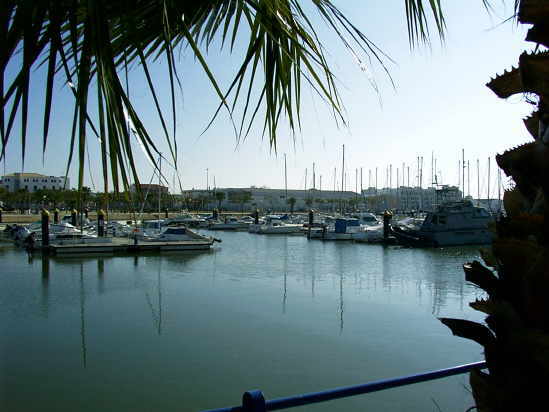|
|
|
|
||||||
| Home Page
|
Welcome to the western Costa de la Luz and the eastern Algarve. Along the River Guadiana we find a breathtaking landscape with an extraordinary scenery. Being at the Spanish province of Huelva on the east side of the river, or the Portuguese banks at the west side, it is an experience never to forget. On this homepage you will find all sorts of information on some of the different areas that cover the eastern Algarve and the Spanish province Huelva:
Just to mention a few. The different areas are catagorized under the links you see at the left side of this page. Enjoy this virtual trip through the area and I hope to see you here some time! AyamonteThe fishing port town of Ayamonte is located in the most western zone of Andalusia, on the mouth of the Guadiana river, that serves as a border with Portugal. Ayamonte has a population of more than 18,000 inhabitants, (which increases considerably during the vacation times) and is united by train with the capital of the province, Huelva; with the Andalusian capital, Seville and withPortugal. Ayamonte unifies all distinctive features of a tourist city: excellent beaches, like those of Isla Canela and the Punta del Moral, splendid landscapes at the foot of the Guadiana an unbelievable artistic cultural asset with unique and privilege at the border to Portugal. The marina is adjacent to the village of Pinillos and is approached via a canal from the river. It is subject to some swell. There is an anchorage in the bay beyond the ferry terminal and fish quays, but landing is difficult from here.
|
 |
||||
| Monte Gordo Lying just 3 km to the west of frontier town Vila Real de Santo Antonio, the once sleepy fishing village of Monte Gordo is the last in a long line of popular beach resorts in the Eastern Algarve. What to see. Opened in July 1996, the towns´ glittering casino features a modern gaming room, more than 200 slot machines and a nightly floorshow.
|
Alcoutim and Sanlucar de Guadiana. From Vila Real de Santo Antonio, at the Atlantic Ocean on the banks of the River Guadiana, you travel northwards to Castro Marim where there is a large Nature Reserve where amongst others thousands of Flamingo´s spend their time feeding. Further upriver at Alamo there is an old Roman Village and the remains of Roman river works. A local museum at Guerreiros Do Rio tells the story of the river and the fishermen who work from its shore. The history of the border village of Alcoutim has always been linked to the river and it looks directly across to its Spanish neighbour, Sanlúcar de Guadiana. Visit the restored Castle which is an archaeological museum and the Church of St Salvador. When you are alone on the way up the Rio Guadiana you get the feeling you're on expedition into something like the Orinoco, then suddenly a few other yachts are there as well: there are two villages here. The Portuguese one is called Alcoutim. The Spanish castle above the town is straight out of the Foreign Legion and looks very impressive. It's high on the hillside and dominates the area. In the villages storks are feeding their young on great nests on the bright white washed red roofed houses.
|
|||||
Donana National Park Donana is the most important Natural Park in Spain. Travel through the nature horsebacking the wonderful "marismas", with an exclusive fauna and flora. The is to be found deep in the West of Andalucia, in the South of Spain. The national reserve is managed at present by the Ministerio de Medio Ambiente, with 50.720 hectares and it is caracterized by the presence of three tipes of ecosystems: · Forest and mediterrenian bush · Mobile Dunes · Swamps In this area we find Mediterranean bush, seasonal swamps, aridity and watered cultives and humid zones transformed in rice fields. Hectares of rivers, pools, canals and lagoons, 7.000 Ha of coast dunes, 43.000 Ha of pine forests and 24.000 Ha of bush. Donana is a habitat for 875 plant species and 226 animal species (birds, fishes, amphibious, reptiles and mammals famous for its wild horses-, all protected). Donana is a winter area for more of six millions of migratory birds: espátulas, flamencos, moritos, avocetas o ánsares. Of this last specie there are until 60.000 units, coming from European countries like Holland, Germany, Sweden or Denmark. In Donana we can find the last Lince iberico (most threatened in the world feline) and the Imperial eagle, both of endemic species in extinction danger.
Questions? Punta Umbria With boats or canoes, one can reach Punta Umbria over the waterway from also Huelva from. At the fishery harbor, one can watch their catch property like the fishers daily pure-brings. The Salts Factory from the time of the Roman Imperial (La Peguera) with a watchtower from the year XVII is artistically appears. From English colonial time, even many constructions of this area come. The near situated highway allows the visitor to reach the capital in about 15 min. Also the airports Sevilla and Faro are to be reached fast over the highway. |
Marismas del Odiel Natural Beauty Spot and Nature Reserve, declared a Biosphere Reserve by UNESCO, this interesting marshy area of 7,185 hectares, is situated at the mouth of the river Odiel, between the towns of Huelva, Gibraleon, Aljaraque and Punta Umbria, from which places access to the park can be gained. In the interior there are the Nature Reserves of the Salt Marshes of El Burro, of 597 hectáres and that of Isla de Enmedio, 480 hectares, which are notable for the degree of preservation of their ecosystems. Flora and Fauna
Properties for sale in this area |
|||||